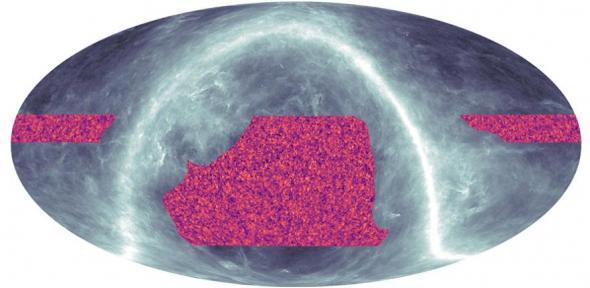
New findings released by an international collaboration involving DAMTP researchers reveal the most detailed map of dark matter distributed across a quarter of the entire sky, reaching deep into the cosmos.
The findings from the Atacama Cosmology Telescope (ACT) collaboration provide further support to Einstein’s theory of general relativity, which has been the foundation of the standard model of cosmology for more than a century. The results offer new methods to demystify dark matter, the unseen mass thought to account for 85% of the matter in the universe.
We have mapped the invisible dark matter across the sky to the largest distances, and clearly see features of this invisible world that are hundreds of millions of light-years across. Blake Sherwin
Blake Sherwin, Professor of Cosmology and Astrophysics in the Department of Applied Mathematics and Theoretical Physics (DAMTP), and a member of DAMTP's Centre for Theoretical Cosmology, leads a team of Cambridge researchers who make up part of the ACT collaboration. "We have mapped the invisible dark matter across the sky to the largest distances, and clearly see features of this invisible world that are hundreds of millions of light-years across," comments Sherwin. "It looks just as our theories predict."
Bending light in a lumpy universe
Although dark matter makes up a large chunk of the universe and shaped its evolution, what exactly it is made of is still a mystery, and it has remained hard to detect because it doesn't interact with light or other forms of electromagnetic radiation. As far as we know, dark matter only interacts with gravity.
To track it down, an international collaboration of more than 160 researchers have built and gathered data from the National Science Foundation's Atacama Cosmology Telescope in the high Chilean Andes. They observe light emanating following the dawn of the universe's formation, when it was only 380,000 years old. Formally, it is known as the cosmic microwave background radiation (CMB), but cosmologists sometimes refer to this diffuse ancient light - the left-over heat from the Big Bang - as the 'baby picture of the universe'. (You can discover more about the CMB in this Plus article)
The new findings, which have been submitted in a series of papers to the Journal of Cosmology and Astroparticle Physics, confirm Einstein's theory about how massive structures grow and bend light, with a test that spans the entire age of the universe. The team tracks how the gravitational pull of large, heavy structures including dark matter warps the CMB on its 14-billion year journey to us, like the way a magnifying glass bends light as it passes through its lens.
"We've made a new mass map using distortions of light left over from the Big Bang," explains Mathew Madhavacheril from the University of Pennsylvania, lead author of one of the papers. "Remarkably, it provides measurements that show that both the 'lumpiness' of the universe, and the rate at which it is growing after 14 billion years of evolution, are just what you'd expect from our standard model of cosmology based on Einstein's theory of gravity."
Resolving a cosmological crisis
"Our results also provide new insights into an ongoing debate some have called 'The Crisis in Cosmology'," said Sherwin. This crisis stems from recent measurements that use a different background light, one emitted from stars in galaxies rather than the CMB. These have produced results that suggest the dark matter was not lumpy enough under the standard model of cosmology and led to concerns that the model may be broken. However, the team's latest results from ACT were able to assess precisely that the vast lumps seen in this image are exactly the right size.
"When I first saw them, our measurements were in such good agreement with the underlying theory that it took me a moment to process the results," said Frank Qu, a PhD student in DAMTP supervised by Blake Sherwin and lead author of one of the new papers. "But we still don't know what the dark matter is, so it will be interesting to see how this possible discrepancy between different measurements will be resolved."
The results are exciting, and there is more yet to come. With ACT having been decommissioned in late 2022, further papers highlighting some of the other final results are slated for submission in the coming year. Observations will continue at the site with the Simons Observatory, including a new telescope due to begin in 2024 that can map the sky almost ten times faster.
"The CMB lensing data rivals more conventional surveys of the visible light from galaxies in their ability to trace the sum of what is out there," said Suzanne Staggs from Princeton University, Director of ACT. "Together, the CMB lensing and the best optical surveys are clarifying the evolution of all the mass in the universe."
"When we proposed this experiment in 2003, this measurement wasn't even on our agenda; we had no idea of the full extent of information that could be extracted from our telescope," said Mark Devlin, from the University of Pennsylvania, Deputy Director of ACT. "We owe this to the cleverness of the theorists, the many people who built new instruments to make our telescope more sensitive, and the new analysis techniques our team came up with."
Image shows a new map of the dark matter made by the Atacama Cosmology Telescope. The orange regions show where there is more mass; purple where there is less. Image credit: ACT Collaboration
This article is adapted from a news story that originally appeared on the University of Cambridge and Centre for Theoretical Cosmology websites. You can find out more about the standard model of cosmology in this article on Plus, part of the Faculty's outreach programme, and discover more about the work of the Stephen Hawking Centre for Theoretical Cosmology here.
